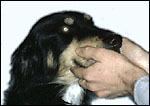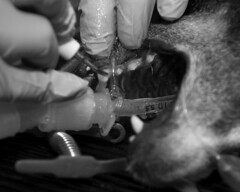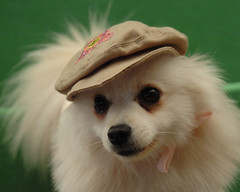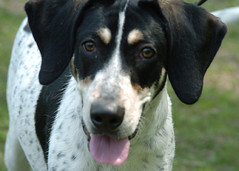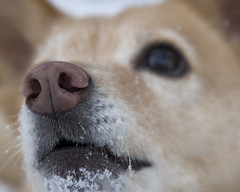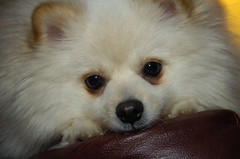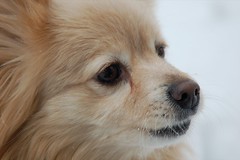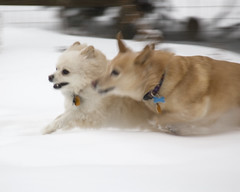Here's some more information on reasons to take my advice about adding fiber to your dog's diet. I find that pumpkin is the easiest because they love the taste, it doesn't add too many calories and it doesn't cause upset stomach.
I found this article by William K. Kruesi, M.S., D.V.M./2001, 2005 at
Cold River Veterinary Center. Please click on the link to visit their website.
"Anal sacs are scent glands of the cat and dog located at 4:00 and 8:00 around the rectum. We frequently see pets with full or impacted anal glands that require manual expression of the glands to relieve pressure.
This causes three problems. First, any time a finger is inserted in the rectum and the scent glands squeezed, the operator is crushing mucosa, the delicate absorptive surface that lines the distal colon and rectum. Crushing intestinal mucosa allows enteric bacteria to pass into the circulation, causing infection. While this infiltration of bacteria may seem insignificant, it may contribute to already high systemic bacteria loads in pets with intestinal permeability (leaky gut syndrome). Second, the procedure hurts, no matter how small the doctor's finger, or how gentle the manipulation. Third, it requires an office visit as most owners do not wish to do the procedure themselves. Some pets would rather not make the trip to a veterinary clinic, for any reason.
No wild felid or canine would suffer the indignity of having a finger pushed in their rectum to squeeze the scent glands. This is a disease of modern living, where commercial pet foods lack sufficient insoluble fiber (bulk) to produce a normal stool volume that helps express the scent glands on a daily basis. In the normal cat or dog, these scent glands are expressed when a large stool passes through the rectum, pushing outward to leave a scant drop of anal gland secretion on the stool. The scent is a marker; it helps to identify individuals and their territory.
Anal glands may also be the site of disease due to abnormal secretions. The normal secretion has the flow characteristics of olive oil, not heavy cream or axle grease. In patients with impaired fat metabolism or bacterial infections the anal glands produce thick, viscous material that does not express easily. The worse situation is a gland filled with inspissated scent: dry, waxy, granular material that doesn't flow. This material must be softened with an emollient or surfactant (lubricant) such as an antiseptic ointment to facilitate drainage. In end-stage anal sacculitis, the glands become inflamed, infected, or dysplastic. The final stage of chronic disease may be cancer, i.e., an anal gland carcinoma.
Anal gland disorders are preventable with proper diet, exercise (to maintain anal sphincter tone), hydration, and fat metabolism. The keys to preventing anal gland impaction are to have adequate fiber and unsaturated fats in the diet. Many commercial pet foods promote their diet as being "so highly digestible, your dog produces smaller stools". Fiber however is essential for normal motility and fermentation within the lower gastrointestinal tract. Domestic dogs and cats generally need more fiber in their diet, not less.
Good sources of fiber include: raw sesame seeds, ground flax seed, psyllium seed (Metamucil), buckwheat, whole oats, brown rice, and wheat bran. We recommend adding 1/2-teaspoon to 2 tablespoons of bran to the patient's diet, from cat to giant dog, daily. Be sure to hydrate the dry fiber thoroughly before incorporating it into their food, so it does not cause intestinal impaction or choke. Ordinary whole grain cereals, bran flakes and the like are fine, so long as the pet does not have a food intolerance (allergy) to wheat or other cereal grains. Consult with your veterinarian for more information on fiber and essential fatty acids for pets. For information on preparing home food for cats and dogs see our recipe page.
At
Cold River Veterinary Center we culture bacteria from anal gland secretions. Our results have been surprising, with the majority of abnormal secretions having obvious bacterial infections; many are antibiotic resistant strains. For chronic or recurrent anal gland abnormalities, contact your veterinarian or call us- we'll be glad to help.
For further information:
• Halnan CR. The frequency of occurrence of anal sacculitis in the dog. J Small Anim Pract 1976 Aug;17(8):537-41
• Halnan CR. Therapy of anal sacculitis in the dog. J Small Anim Pract 1976 Oct;17(10):685-91
• Isitor GN. Comparative ultrastructural study of normal, adenomatous, carcinomatous, and hyperplastic cells of canine hepatoid circumanal gland. Am J Vet Res 1983 Mar;44(3):463-74
• Rosol TJ, Capen CC, Danks JA, Suva LJ, Steinmeyer CL, Hayman J, Ebeling PR, Martin TJ. Identification of parathyroid hormone-related protein in canine apocrine adenocarcinoma of the anal sac. Vet Pathol 1990 Mar;27(2):89-95
• van Duijkeren E. Disease conditions of canine anal sacs. J Small Anim Pract 1995 Jan;36(1):12-6"



